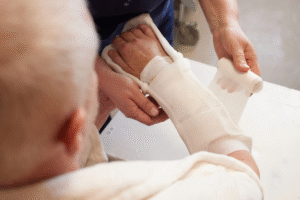Understanding Hip Resurfacing and Why Patients Choose It Over Replacement
Hip resurfacing is a surgical procedure designed to treat advanced hip arthritis or joint damage while preserving more of the natural bone structure than a traditional hip replacement. Instead of completely removing the femoral head, the surgeon reshapes it and caps it with a smooth metal covering, while the hip socket is fitted with a matching metal cup. This approach allows patients to maintain more natural joint mechanics and retain better bone density for the long term. Many people choose hip resurfacing over replacement because it can provide improved mobility, especially for younger and more active individuals. The procedure is often recommended for patients who want to return to sports, running, or physically demanding work after recovery. Compared to traditional replacements, hip resurfacing tends to have lower rates of dislocation, which makes it appealing to active lifestyles. Patients who explore hip resurfacing abroad often do so for cost, access to expertise, and the promise of quicker care.
Why Consider Hip Resurfacing Abroad?
For many patients, the decision to undergo hip resurfacing abroad stems from a combination of financial and medical reasons. In countries such as the United States, the cost of orthopedic surgeries can be overwhelming, even with insurance coverage. Traveling abroad opens the door to significantly reduced medical expenses while still receiving treatment in highly advanced facilities. Beyond cost savings, another major advantage is shorter waiting times. In some countries, patients may wait months or even years for surgery, while abroad they can often schedule procedures in a matter of weeks. Hip resurfacing abroad also gives access to internationally trained surgeons who specialize in the procedure and may have more experience compared to local providers. For many patients, pairing medical treatment with travel to destinations that also offer recovery-friendly environments adds to the appeal. Ultimately, hip resurfacing abroad offers a combination of affordability, accessibility, and expertise that attracts thousands of patients every year.
Top Countries for Hip Resurfacing Abroad
When considering hip resurfacing abroad, several countries stand out for their reputation in orthopedic surgery. India is a leading destination, known for its world-class orthopedic specialists, modern hospitals, and significantly lower costs compared to Western nations. Thailand also attracts many patients due to its internationally accredited hospitals, English-speaking medical staff, and strong track record in medical tourism. Turkey has positioned itself as a hub for advanced orthopedic procedures, with top surgeons often trained in Europe or the United States. Mexico provides an option closer to North America, making it convenient for U.S. and Canadian patients who want lower costs without traveling across the globe. In Eastern Europe, countries such as Hungary, Poland, and the Czech Republic are gaining recognition for high-quality care at affordable prices. Each destination has its own strengths, from affordability to high-volume surgical expertise, and patients should carefully research which country best fits their medical and personal needs.
Factors to Consider Before Traveling for Surgery
Before making the decision to undergo hip resurfacing abroad, careful planning and research are essential. Patients should start by evaluating the credentials of surgeons and hospitals, ensuring they are board-certified and ideally affiliated with international accreditation bodies. Cost is another important factor to review, as it is not only the surgery that matters but also additional expenses like hospital stays, travel, accommodation, and rehabilitation. Language and communication should also be considered, as patients need to feel confident they can clearly discuss medical concerns and recovery plans. The travel logistics themselves can present challenges, since long flights after hip surgery can increase risks if not carefully managed. Patients should also think about how follow-up care will be arranged once they return home. Cultural factors may play a role as well, as the comfort level with being treated in a foreign environment can impact the overall experience. Taking time to review all these considerations helps reduce risks and ensures a smoother medical journey.
Comparing Costs: Domestic vs. Abroad
One of the main reasons patients look into hip resurfacing abroad is the potential for substantial cost savings. In the United States, hip resurfacing procedures can cost anywhere from $35,000 to $50,000, depending on the hospital and surgeon. In contrast, the same surgery abroad can often be performed for $8,000 to $15,000, including hospital fees, anesthesia, and sometimes even rehabilitation. Countries like India and Thailand are especially known for offering complete medical packages that cover consultations, surgery, and post-operative care. Mexico and Eastern Europe also provide cost-effective solutions, often cutting expenses by more than half. It is important, however, to look beyond the numbers and assess what is included in the quoted price. For example, some hospitals abroad offer bundled packages with accommodation, transportation, and a medical liaison, making the process smoother for international patients. While cost is a major factor, patients should prioritize safety, expertise, and long-term health outcomes when making their decision.
Preparing for Hip Resurfacing Abroad
Successful hip resurfacing abroad begins long before boarding a plane. Patients should undergo thorough medical evaluations at home to confirm they are suitable candidates for the procedure. Sharing detailed medical records with the chosen hospital ensures surgeons are well prepared for the operation. Travel documents, including passports, medical visas, and comprehensive travel insurance, should be arranged in advance. A packing checklist should include comfortable clothing, essential medications, medical documents, and any mobility aids recommended by the surgeon. Patients should also plan for their recovery timeline, which may require several weeks abroad before being cleared for travel. Setting realistic expectations for healing and understanding the physical demands of rehabilitation are crucial for long-term success. With the right preparation, traveling for hip resurfacing abroad can be a smooth and positive experience.
Recovery and Aftercare in a Foreign Country
Recovery is a vital stage of the hip resurfacing journey, and many international hospitals provide comprehensive aftercare for their patients. Typically, hospital stays last four to seven days, followed by physical therapy to regain strength and mobility. Some medical tourism destinations include access to rehabilitation centers with specialized staff who guide patients through recovery exercises. Aftercare often includes follow-up appointments to monitor healing and ensure the implant is functioning correctly. Patients should also prepare for how their care will transition once they return home. Coordinating with a local physician to handle check-ups and imaging can help maintain continuity. While being in a foreign country for recovery may feel daunting, many hospitals provide patient coordinators who assist with everything from medical communication to logistics, ensuring a smoother process. Quality aftercare is just as important as the surgery itself, and patients should ensure it is part of their overall plan.
Potential Risks and How to Minimize Them
Like any surgical procedure, hip resurfacing abroad carries risks that patients should understand before committing. Potential complications include infection, blood clots, implant loosening, or fracture around the implant. Traveling abroad can add unique challenges, such as long flights increasing the risk of blood clots, or difficulties accessing follow-up care once back home. Patients can reduce these risks by selecting hospitals with international accreditations, verifying the surgeon’s experience, and asking detailed questions during consultations. Arranging for proper post-operative care and ensuring medical insurance covers potential complications can also provide peace of mind. Clear communication with the surgical team about personal health conditions is critical to lowering risks. Patients should not focus solely on price but balance affordability with quality and safety. By being proactive and informed, patients can minimize risks and increase the likelihood of a successful outcome.
Patient Experiences and Outcomes
Many patients who undergo hip resurfacing abroad report significant improvements in their quality of life. The preservation of natural bone structure often allows for greater mobility and comfort compared to traditional hip replacement. Athletes and active individuals particularly value the ability to return to sports and other physical activities. Cost savings also contribute to positive experiences, as patients feel they have received excellent care without financial strain. Hospitals abroad often cater specifically to international patients, providing personalized service, language support, and streamlined care packages. Outcomes tend to be positive when patients carefully research their options and select highly qualified medical providers. While individual experiences vary, overall, hip resurfacing abroad has helped thousands regain mobility, independence, and confidence in their daily lives.
Frequently Asked Questions (FAQ)
Is hip resurfacing abroad safe?
Yes, when performed in internationally accredited hospitals by experienced surgeons, hip resurfacing abroad can be safe. Patients should thoroughly research medical providers and ensure they meet global healthcare standards.
How much can I expect to save compared to U.S. surgery costs?
Savings can range from 50% to 70% depending on the destination. Countries like India, Thailand, and Mexico often provide the most significant cost reductions while maintaining quality care.
How do I find the best surgeons and hospitals?
Look for hospitals with international accreditations and surgeons who specialize in hip resurfacing with proven track records. Patient reviews and direct consultations can provide valuable insights.
What happens if complications arise once I return home?
Patients should arrange local follow-up care with their primary physician or an orthopedic specialist. Some hospitals abroad also offer virtual consultations to support patients after returning home.
Is hip resurfacing abroad covered by insurance?
Coverage varies depending on the insurance provider. Some policies may reimburse part of the procedure abroad, while others require patients to pay out of pocket. Checking with the insurance company before planning is essential.











